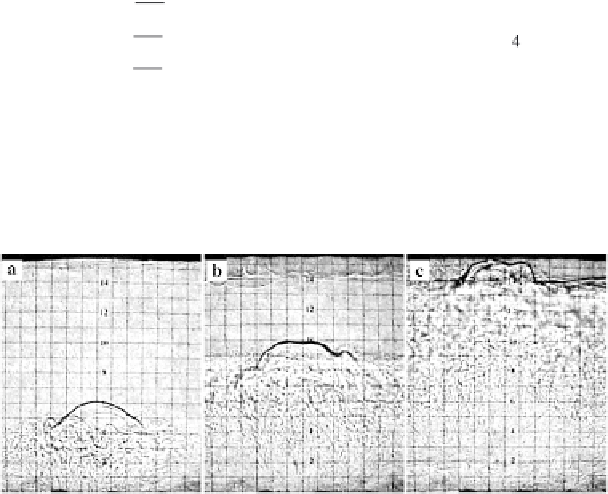Geoscience Reference
In-Depth Information
Fig. 7.20 Layout of experimental set-up. 1—piston undergoing vertical oscillations, 2—source of
light (quasiparallel rays), 3—semitransparent screen, 4—digital photocamera
Fig. 7.21 Shadow pictures of the destruction of continuous stratification in the case of harmonic
oscillations of a section of the bottom. The step of the net is 1 cm. Pictures (a), (b) and (c) are
arranged according to the increase of the piston oscillation velocity
in all cases amounted to 0.16 m. Visualization of dynamic processes in the basin was
performed by the shadow method. Registration of shadow pictures was done with
the aid of a digital photocamera.
Figure 7.21 presents typical shadow pictures, reflecting the dynamics of pro-
cesses in a stratified liquid over an oscillating section of the bottom (the piston).
Above the piston a 'dome' forms, the height of which is determined by the density
gradient and the oscillation velocity of the piston. At fixed oscillation frequency and
amplitude of the piston the height of the dome changes slowly.
The reason the dome arises consists in the extremely pronounced turbulized flow,
concentrated above the central part of the piston inside a cylindrical region 2-3 cm in
diameter. The flow is directed vertically upward. In absence of stratification the max-
imum flow velocity (a visual estimate) amounted to 10 cm s
−
1
. Near the walls of
the basin relatively slow lowering of the liquid proceeded.
On the water surface structures of standing waves formed, which also led to
destruction of the stratification in the surface layer of thickness about 2 cm, which is
well seen in the shadow picture. In the case of high oscillation velocities of the piston
(Fig. 7.21c) the upper mixed layer and the turbulized flow closed: 'the depth waters
reached the surface'.







